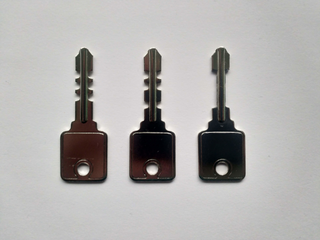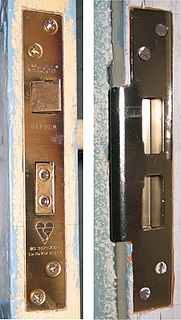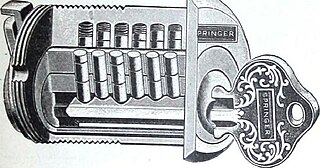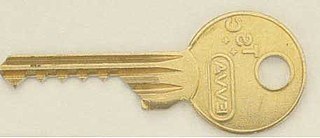
Locksmithing is the science and art of making and defeating locks. Locksmithing is a traditional trade and in many countries requires completion of an apprenticeship. The level of formal education legally required varies from country to country from none at all, to a simple training certificate awarded by an employer, to a full diploma from an engineering college, in addition to time spent working as an apprentice.

Lock picking is the practice of unlocking a lock by manipulating the components of the lock device without the original key.

A warded lock is a type of lock that uses a set of obstructions, or wards, to prevent the lock from opening unless the correct key is inserted. The correct key has notches or slots corresponding to the obstructions in the lock, allowing it to rotate freely inside the lock.

The pin tumbler lock is a lock mechanism that uses pins of varying lengths to prevent the lock from opening without the correct key. Pin tumblers are most commonly employed in cylinder locks, but may also be found in tubular pin tumbler locks.

A disc tumbler or disc detainer lock is a lock composed of slotted rotating detainer discs. The lock was invented by Finnish founder of Abloy, Emil Henriksson (1886–1959) in 1907 and first manufactured under the Abloy brand in 1918.

A lock is a mechanical or electronic fastening device that is released by a physical object, by supplying secret information, by a combination thereof, or it may only be able to be opened from one side, such as a door chain.

A lever tumbler lock is a type of lock that uses a set of levers to prevent the bolt from moving in the lock. In the simplest form of these, lifting the tumbler above a certain height will allow the bolt to slide past.

A Chubb detector lock is a lever tumbler lock with an integral security feature, a re-locking device, which frustrates unauthorised access attempts and indicates to the lock's owner that it has been interfered with. When someone tries to pick the lock or to open it using the wrong key, the lock is designed to jam in a locked state until either a special regulator key or the original key is inserted and turned in a different direction. This alerts the owner to the fact that the lock has been tampered with.

A mortise lock is a lock that requires a pocket—the mortise—to be cut into the edge of the door or piece of furniture into which the lock is to be fitted. In most parts of the world, mortise locks are found on older buildings constructed before the advent of bored cylindrical locks, but they have recently become more common in commercial and upmarket residential construction in the United States. The design is widely used in domestic properties of all vintages in Europe.

Safe-cracking is the process of opening a safe without either the combination or the key.

Padlocks are portable locks with a shackle that may be passed through an opening to prevent use, theft, vandalism or harm.
Medeco, a subsidiary of the Swedish Assa Abloy Group, is a lock manufacturer located in Roanoke County, Virginia, United States.
Rekeying a lock is replacing the old lock pins with new lock pins.

A master key operates a set of several locks. Usually, there is nothing special about the key itself, but rather the locks into which it will fit. These master-keyed locks are configured to operate with two, or more, different keys: one specific to each lock, which cannot operate any of the others in the set, and the master key, which operates all the locks in the set. Locks that have master keys have a second set of the mechanism used to operate them that is identical to all of the others in the set of locks. For example, master keyed pin tumbler locks often have two shear points at each pin position, one for the change key and one for the master key. A far more secure system has two cylinders in each lock, one for the change key and one for the master key.

Lock bumping is a lock picking technique for opening a pin tumbler lock using a specially crafted bump key, rapping key or 999 key. A bump key must correspond to the target lock in order to function correctly.

A wafer tumbler lock is a type of lock that uses a set of flat wafers to prevent the lock from opening unless the correct key is inserted. This type of lock is similar to the pin tumbler lock and works on a similar principle. However, unlike the pin tumbler lock, where each pin consists of two or more pieces, each wafer in the lock is a single piece. The wafer tumbler lock is often incorrectly referred to as a disc tumbler lock, which uses an entirely different mechanism.

A snap gun, also known as lock pick gun, pick gun, or electric lock pick, is a tool that can be used to open a mechanical pin tumbler lock without using the key. A steel rod is inserted into the lock and the snap gun briefly fires the rod against all of the lock pins simultaneously, momentarily freeing the cylinder and enabling it to be turned using a tension wrench. The snap gun is an alternative to a conventional lockpick, which requires other techniques such as raking to free the pins.

Bilock is a high-security keying system designed and manufactured by Australian Lock Company. It is advertised to be bump-proof, pick-resistant, and drill-resistant. The Bilock cylinder uses a patented locking system with two sidebars, 12 pins, and 12 springs. In the New Generation Bilock, a trigger pin has been added to increase security and extend the registered design of the product. The key design is a U-shape profile with six cuts on each side of the key, along with a central roller to activate the trigger pin in the front and center of the cylinder.
The term protector lock has referred to two unrelated lock designs, one invented in the 1850s by Alfred Hobbs, the other in 1874 by Theodor Kromer.
This is a glossary of locksmithing terms.





















